| Listing 1 - 10 of 29 | << page >> |
Sort by
|
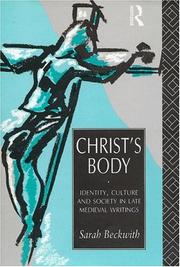
ISBN: 0415144264 Year: 1996 Publisher: London New York Routledge
Abstract | Keywords | Export | Availability | Bookmark
 Loading...
Loading...Choose an application
- Reference Manager
- EndNote
- RefWorks (Direct export to RefWorks)
Book
ISBN: 2204077933 9782204077934 Year: 2005 Publisher: Paris: Cerf,
Abstract | Keywords | Export | Availability | Bookmark
 Loading...
Loading...Choose an application
- Reference Manager
- EndNote
- RefWorks (Direct export to RefWorks)
Book
ISBN: 0415044200 9780415044202 Year: 1993 Publisher: London: Routledge,
Abstract | Keywords | Export | Availability | Bookmark
 Loading...
Loading...Choose an application
- Reference Manager
- EndNote
- RefWorks (Direct export to RefWorks)
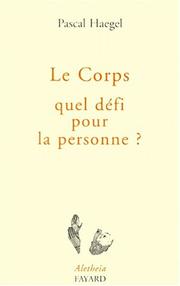
ISBN: 2213603731 9782213603735 Year: 1999 Publisher: Paris: Fayard,
Abstract | Keywords | Export | Availability | Bookmark
 Loading...
Loading...Choose an application
- Reference Manager
- EndNote
- RefWorks (Direct export to RefWorks)
Du corps, il n'en aura jamais été autant question qu'en cette aurore du troisième millénaire. [...] Ce corps, qu'est il appelé à devenir? Mais au fait, qu'est-il donc? Pourquoi le corps? C'est à une telle recherche qu'invite ce livre. En suivant le fil d'Ariane du corps, il nous conduit au coeur de ce qu'il faut bien appeler le "mystère" de la matière. Peut-on redécouvrir la distinction de l'âme et du coprs, de l'esprit et de la matière? Là est le passage obligé pour pointer la vraie finalité de la personne humaine. Alors s'ouvre le chemin vers le plein accomplissement de l'homme. La matière vient dès lors incarner l'amour vécu jusqu'au bout.
Body, Human (Philosophy) --- Body, Human --- Religious aspects --- Christianity. --- Human body (Philosophy) --- Human body --- Human beings --- Body image --- Human anatomy --- Human physiology --- Mind and body --- Philosophy --- Religious aspects&delete& --- Christianity --- Body, Human - Religious aspects - Christianity.
Book
ISBN: 2204041750 9782204041751 Year: 1991 Volume: 161 Publisher: Paris: Cerf,
Abstract | Keywords | Export | Availability | Bookmark
 Loading...
Loading...Choose an application
- Reference Manager
- EndNote
- RefWorks (Direct export to RefWorks)
Church. --- Human body --- Salvation. --- Religious aspects --- Christianity. --- Body, Human --- Body, human --- -Salvation --- Church --- 234 --- Ecclesiastical theology --- Ecclesiology --- Theology, Ecclesiastical --- People of God --- Theology --- Salvation --- Religion --- Human beings --- Body image --- Human anatomy --- Human physiology --- Mind and body --- -Christianity --- Soteriologie. Heilsleer. Genade. Geloof --- Religious aspects&delete& --- Christianity --- Body, Human - Religious aspects - Christianity.
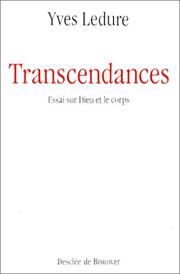
ISBN: 222003061X 9782220030616 Year: 1989 Publisher: Paris: Desclée De Brouwer,
Abstract | Keywords | Export | Availability | Bookmark
 Loading...
Loading...Choose an application
- Reference Manager
- EndNote
- RefWorks (Direct export to RefWorks)
Religion --- Body, Human --- -Philosophical anthropology --- Religious aspects --- Philosophical anthropology --- -233 --- #GCLD: Ecrits SCJ --- Human beings --- Body image --- Human anatomy --- Human physiology --- Mind and body --- Anthropology, Philosophical --- Man (Philosophy) --- Civilization --- Life --- Ontology --- Humanism --- Persons --- Philosophy of mind --- Religion, Primitive --- Atheism --- God --- Irreligion --- Religions --- Theology --- De mens. Theologische antropologie --- Philosophy --- Human body --- 233 --- Body, Human (in religion, folk-lore, etc.) --- Body, Human - - Religious aspects
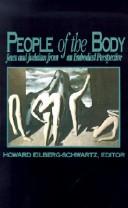
ISBN: 0791411699 0791411702 9780791411704 9780791411698 Year: 1992 Publisher: Albany: State university of New York press,
Abstract | Keywords | Export | Availability | Bookmark
 Loading...
Loading...Choose an application
- Reference Manager
- EndNote
- RefWorks (Direct export to RefWorks)
Sex --- Body, Human --- Purity, Ritual --- Women in Judaism. --- Judaism --- Religious aspects --- Judaism. --- Doctrines. --- Human body --- Corps humain --- Pureté rituelle --- Femmes dans le judaïsme --- Judaïsme --- Aspect religieux --- Doctrines --- Pureté rituelle --- Femmes dans le judaïsme --- Judaïsme --- Sex - Religious aspects - Judaism. --- Body, Human - Religious aspects - Judaism. --- Purity, Ritual - Judaism. --- Judaism - Doctrines.
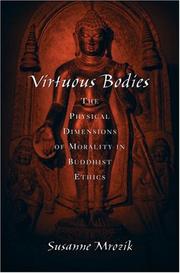
ISBN: 9780195305005 0195305000 0199785686 1281163023 1435620100 9786611163020 0198041497 Year: 2007 Publisher: New York: Oxford university press,
Abstract | Keywords | Export | Availability | Bookmark
 Loading...
Loading...Choose an application
- Reference Manager
- EndNote
- RefWorks (Direct export to RefWorks)
Virtuous Bodies breaks new ground in the field of Buddhist ethics by investigating the diverse roles bodies play in ethical development. Traditionally, Buddhists assumed a close connection between body and morality. Thus Buddhist literature contains descriptions of living beings that stink with sin, are disfigured by vices, or are perfumed and adorned with virtues. Taking an influential early medieval Indian Mahayana Buddhist text-Santideva's Compendium of Training (Siksasamuccaya)-as a case study, Susanne Mrozik demonstrates that Buddhists regarded ethical development as a process of physical and moral transformation. Mrozik chooses The Compendium of Training because it quotes from over one hundred Buddhist scriptures, allowing her to reveal a broader Buddhist interest in the ethical significance of bodies. The text is a training manual for bodhisattvas, especially monastic bodhisattvas. In it, bodies function as markers of, and conditions for, one's own ethical development. Most strikingly, bodies also function as instruments for the ethical development of others. When living beings come into contact with the virtuous bodies of bodhisattvas, they are transformed physically and morally for the better. Virtuous Bodies explores both the centrality of bodies to the bodhisattva ideal and the corporeal specificity of that ideal. Arguing that the bodhisattva ideal is an embodied ethical ideal, Mrozik poses an array of fascinating questions: What does virtue look like? What kinds of physical features constitute virtuous bodies? What kinds of bodies have virtuous effects on others? Drawing on a range of contemporary theorists, this book engages in a feminist hermeneutics of recovery and suspicion in order to explore the ethical resources Buddhism offers to scholars and religious practitioners interested in the embodied nature of ethical ideals.
Body, Human --- Buddhist ethics. --- Religious aspects --- Buddhism. --- Śāntideva, --- 294.35 --- Religious ethics --- Human beings --- Body image --- Human anatomy --- Human physiology --- Mind and body --- Boeddhisme: Dhamma--(morele wet) --- Santideva, --- Śāntideva, --- Human body --- 294.35 Boeddhisme: Dhamma--(morele wet) --- Buddhist ethics --- Religious aspects&delete& --- Buddhism --- Body, Human - Religious aspects - Buddhism. --- Śāntideva, - 7th cent. - Śikṣāsamuccaya.
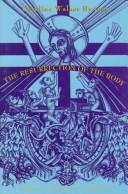
ISBN: 0231081278 023108126X 0231546084 0231515626 9780231081269 Year: 1995 Volume: new ser., no. 15 Publisher: New York (N.Y.): Columbia university press,
Abstract | Keywords | Export | Availability | Bookmark
 Loading...
Loading...Choose an application
- Reference Manager
- EndNote
- RefWorks (Direct export to RefWorks)
A classic of medieval studies, The Resurrection of the Body in Western Christianity, 200-1336 traces ideas of death and resurrection in early and medieval Christianity. Caroline Walker Bynum explores problems of the body and identity in devotional and theological literature, suggesting that medieval attitudes toward the body still shape modern notions of the individual. This expanded edition includes her 1995 article "Why All the Fuss About the Body? A Medievalist's Perspective," which takes a broader perspective on the book's themes. It also includes a new introduction that explores the context in which the book and article were written, as well as why the Middle Ages matter for how we think about the body and life after death today.
Christian dogmatics --- Resurrection --- Human body --- Résurrection --- Corps humain --- History of doctrines --- Religious aspects --- Christianity --- Histoire des doctrines --- Aspect religieux --- Christianisme --- Body, Human --- 236.8 --- -Body, Human --- -Resurrection --- -Future life --- Human beings --- Body image --- Human anatomy --- Human physiology --- Mind and body --- Opstanding van de doden. Staat van het gelukzalig lichaam. Staat van het verdoemde lichaam --- -Religious aspects --- -Christianity --- -History of doctrines --- -Opstanding van de doden. Staat van het gelukzalig lichaam. Staat van het verdoemde lichaam --- -236.8 --- 236.8 Opstanding van de doden. Staat van het gelukzalig lichaam. Staat van het verdoemde lichaam --- -236.8 Opstanding van de doden. Staat van het gelukzalig lichaam. Staat van het verdoemde lichaam --- Résurrection --- Future life --- History --- Resurrection - History of doctrines - Early church, ca 30-600 --- Resurrection - History of doctrines - Middle Ages, 600-1500. --- Body, Human - Religious aspects - Christianity - History of doctrines - Early church, ca. 30-600. --- Body, Human - Religious aspects - Christianity - History of doctrines - Middle Ages, 600-1500.
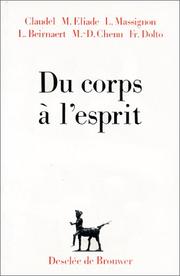
ISBN: 222003089X 9782220030890 Year: 1989 Publisher: Paris: Desclée De Brouwer,
Abstract | Keywords | Export | Availability | Bookmark
 Loading...
Loading...Choose an application
- Reference Manager
- EndNote
- RefWorks (Direct export to RefWorks)
Philosophical anthropology --- Christian moral theology --- Experience (Religion) --- Body, Human --- Heart --- Religious aspects --- 248.1 --- -Heart --- -Experience (Religion) --- Religious experience --- Psychology, Religious --- Cardiopulmonary system --- Cardiovascular system --- Chest --- Human beings --- Body image --- Human anatomy --- Human physiology --- Mind and body --- Ascetische theologie --- 248.1 Ascetische theologie --- Human body --- Body, Human (in religion, folk-lore, etc.) --- Heart (in religion, folk-lore, etc.) --- Body, Human - Religious aspects --- Heart - Religious aspects
| Listing 1 - 10 of 29 | << page >> |
Sort by
|

 Search
Search Feedback
Feedback About UniCat
About UniCat  Help
Help News
News